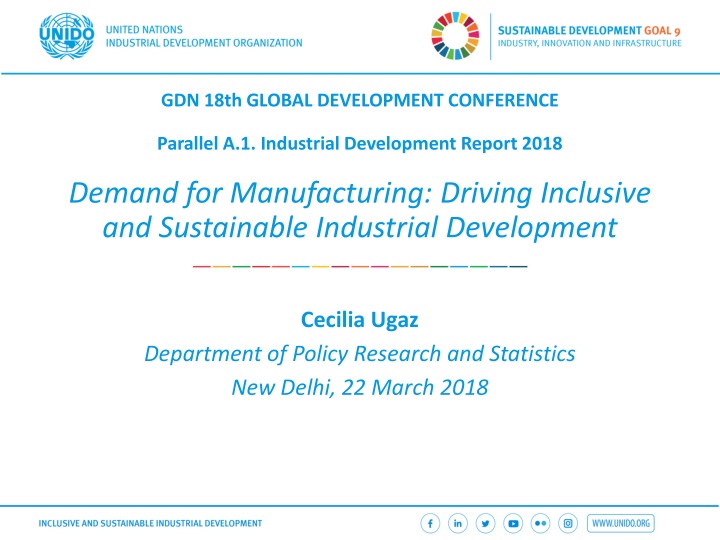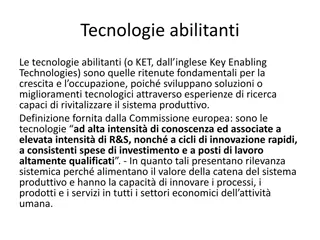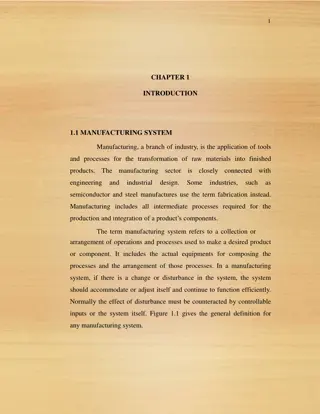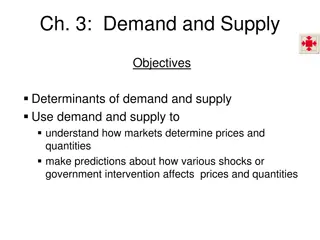Demand for Manufacturing: Driving Inclusive and Sustainable Industrial Development
The Industrial Development Report (IDR) 2018 shifts focus to demand-side dynamics, emphasizing the crucial role of manufacturing in providing affordable goods to consumers worldwide. By analyzing the impact of industrialization on daily life, the report highlights how a demand-driven approach can foster inclusive and sustainable industrial development. It delves into the continuous evolution of manufacturing, showcasing how new and improved products have revolutionized human behavior and accessibility. With declining manufacturing prices compared to overall costs, the report underscores the importance of addressing manufacturing demand to drive global industrial progress.
Download Presentation

Please find below an Image/Link to download the presentation.
The content on the website is provided AS IS for your information and personal use only. It may not be sold, licensed, or shared on other websites without obtaining consent from the author.If you encounter any issues during the download, it is possible that the publisher has removed the file from their server.
You are allowed to download the files provided on this website for personal or commercial use, subject to the condition that they are used lawfully. All files are the property of their respective owners.
The content on the website is provided AS IS for your information and personal use only. It may not be sold, licensed, or shared on other websites without obtaining consent from the author.
E N D
Presentation Transcript
GDN 18th GLOBAL DEVELOPMENT CONFERENCE Parallel A.1. Industrial Development Report 2018 Demand for Manufacturing: Driving Inclusive and Sustainable Industrial Development Cecilia Ugaz Department of Policy Research and Statistics New Delhi, 22 March 2018
The Industrial Development Report (IDR) Biannual publication that addresses the most pressing issues of inclusive and sustainable industrial development facing the world The report combines UNIDO s own research with inputs from leading experts on the field Each edition has a particular focus. In the past, the focus was mostly on supply-side issues: IDR 2011: Energy efficiency IDR 2013: Employment creation IDR 2016: Technology & innovation 2
IDR 2018: Bringing demand into scene Focus on supply-side relegated important issues - Role of manufacturing in welfare of millions of people by providing new, better and cheaper goods. - The consumption of manufactured goods (manufacturing demand) - key for the emergence and expansion of a domestic industrial sector. IDR 2018 examines global industrialization from a demand perspective (consumption of manufactured goods) - Impact of industrial development on our daily life. - Policy relevance - focus on demand can foster inclusive and sustainable industrial development (ISID). 3
The importance of industrial development for consumers 4
Manufacturing produces new, better and more affordable goods Industrial development - continuous creation of new goods and improvement in the quality of existing ones: - Throughout industrial revolutions manufacturing has been a provider of new goods - Manufactured goods revolutionized human behavior in terms of working, traveling, communicating, entertaining etc. New goods typically emerge as luxuries only accessible to rich consumers At the next stage industrial products become affordable to an increasingly larger number of households. 5
Manufacturing prices are falling - compared to overall prices Implicit gross value added deflator (1991=100) 180 1.1 Relative price of manufactures Aggregate relative price of manufactured goods down by 27 percent in last 25 years 160 1.0 140 0.9 Deflator, total economy 120 0.8 Relative price of manufactures (right axis) 100 Deflator, manufacturing industries 80 0.7 1991 1994 1997 2000 2003 2006 2009 2012 Source: UNIDO elaboration based on the Manufacturing Value Added 2017 database. 6
and consumer goods are diffusing massively around the world b. Developing and emerging industrial economies a. Industrialized economies 100 100 Household ownership (percent) Household ownership (percent) Refrigerator Colour TV Colour TV Mobile Telephone 75 75 Washing Machine Mobile Telephone Refrigerator Personal Computer 50 50 Personal Computer Washing Machine Passenger Car Microwave Oven 25 25 Passenger Car Smart Phone Smart Phone Microwave Oven 0 0 1980 1985 1990 1995 2000 2005 2010 2015 1980 1985 1990 1995 2000 2005 2010 2015 Source: UNIDO elaboration based on Euro-monitor International (Economies and Consumers; Possession of Household Durables, 2016). 7
Summarizing Key Message 1: Industrialization improves our living standards. It brings new and better goods that, through time, become affordable for an increasing number of people. 8
The importance of consumers for industrial development 9
Industrial development needs demand for domestic manufactures New industries can emerge when sufficient demand for their products is in place. Achieving SDG 9 requires demand for domestic manufacturers. Under the right set of conditions, consumption can set in motion a virtuous circle of demand, diversification and industrial development - As incomes grow, demand diversifies away from necessities towards new varieties and qualities of goods - [variety effect] - New industries gain scale and increase production efficiency. It leads to the decline of price and massification of consumption - [volume effect] - Further price declines due to competition and innovation increase the purchasing power of consumers and allow them to diversify their expenditures - [price effect] 10
A virtuous circle of manufacturing consumption and industrial development Increase in discretionary income New income Augmented purchasing power of all consumers shifts demand from necessities to other goods Price effect Variety effect Global wages and profits Decline in prices of massified goods Diversification of manufacturing demand Volume effect Competition and innovation increase efficiency further Consolidation of industry increases production efficiency Massification of manufacturing demand 11
Importance of domestic demand for industrial development Changing trends in the relative importance of domestic absorption of manufacturing goods Demand can originate from internal sources (domestic absorption) or external sources (exports) Domestic absorption is a key driver of income generation along the virtuous circle: 100 Share of domestic absorption in final demand for manufacturing goods Least developed countries Other developing economies 90 Emerging industrial economies - Domestic absorption accounts for the largest share of final demand across the world. World 80 - As countries industrialize, the importance of domestic absorption declines To benefit from domestic demand, countries need to: 70 Industrialized economies - Improve their income distribution; 60 1990 1992 1994 1996 1998 2000 2002 2004 2006 2008 2010 2012 - Strengthen real wages; and Source: de Macedo and Lavopa (2017) based on the Eora Multi-Region Input-Output database. - Build industrial capabilities 12
Importance of external demand for industrial development Increasing the purchasing power of exports is associated with higher growth rates in per capita GDP Serving external demand creates incomes for local producers and fuels the virtuous circle It also provides foreign exchange to import goods and avoid balance of payment tensions The extent to which these opportunities materialize depend on the purchasing power of exports. To benefit from external demand, countries need to: 250 Change in manufacturing income terms of trade (Index, 2003 = 100) Other developing, Europe Other developing, Asia & Pacific Emerging, Asia & Pacific LDCs, Asia & Pacific 200 Fitted values (omitting LDCs, Africa) Emerging, Europe Industrialized, Europe 150 Other developing, Africa Other developing, America Industrialized, Asia & Pacific 100 Industrialized, America Emerging, America Emerging, Africa 50 - Upgrade the technology content and quality of exports; 0.2 0.3 0.4 0.5 0.6 0.7 0.8 0.9 1.0 1.1 1.2 Growth in GDP per capita (percent) - Diversify export destinations and enter into markets with higher incomes. Source: UNIDO elaboration based on BACI International Trade Database. 13
Summarizing Key Message 2: Consumption is a key driver of industrial development. Under the right set of conditions it set in motion a virtuous circle of demand diversification, income creation and inclusive industrialization (SDG 9). 14
Moving towards sustainable manufacturing consumption 15
Income creation vs. pressures on environment Global biocapacity went into the red nearly half a century ago Consumption leads towards a virtuous circle, but this circle is not necessarily environmentally sustainable. Higher demand requires the use of more natural resources and carbon energy; causes increase in CO2 emission and residuals. If all countries replicate the consumption pattern observed today in the world, environmental sustainability would be at risk 4 Global hectares per person Ecological Reserve Ecological footprint 3 Ecological Deficit 2 Biocapacity 1 0 1961 1965 1969 1973 1977 1981 1985 1989 1993 1997 2001 2005 2009 2013 Source: Global Footprint Network National Footprint Accounts, 2017 Edition. 16
Sustainability requires a shift in consumption patterns towards environmental goods Export share of environmental goods on the rise Environmental goods: Average share of enviornmental goods in total exports (percent) 10 i. have a lower environmental impact in the production process 8 ii. do not pose a threat in terms of waste disposal 7.3 World 6 iii. require lower use of materials Development of markets for these goods can help creating a sustainable virtuous circle of manufacturing consumption However, the market for environmental goods is still niche: High-income economies 4 2 Middle- and low- income economies 0 1988 1991 1994 1997 2001 2004 2012 - It has been growing in all countries Source: UNIDO elaboration based on the United Nations Comtrade database - but represents less than 8% of world exports 17
Summarizing Key Message 3: The impact on environment from massification of consumption can be reduced through the technological innovation and development of environmental goods. Shifting consumption patterns towards environmental goods is key to render the virtuous circle sustainable. 18
Demand-driven industrial policies to foster ISID 19
Scope of government action Changes in demand offer opportunities for industrialization and the generation of new incomes and welfare Demand can be either a framework condition partially or completely outside the control of policy makers, or a variable that is actionable through public policy IDR 2018 proposes different policy interventions for both cases 20
Policies to capture income from demand, when demand is given Government as a facilitator - Facilitate removal of market failures and build on current comparative advantages to tackle emerging demand opportunities for industrialization. Government as technological capacity building partner - Promote the building of technological and productive capabilities to enter sectors that it would otherwise be impossible to develop given traditional comparative advantages. Government as a market antenna - Develop capacities and adopt measures to help domestic agents identify or anticipate changes in demand for manufacturing products. 21
Policies to shift demand towards specific goals Environment-friendly policy National industrial policies could steer the demand of environment-friendly goods (e.g. carbon prices policies and regulation). Regulation towards consumption Stimulate and regulate consumption of manufacturing products or influence consumer behavior through changes in relative prices. Partnership with the private sector Promote/enhance/create demand for innovative products by targeting final users; disseminate knowledge and information on market opportunities. 22
Summarizing Key Message 4: Demand considerations broaden the scope of government action to address broad economic and inclusive and sustainable industrial development outcomes. 23
Thank you Kindly send your comment to idr2018@unido.org 24























